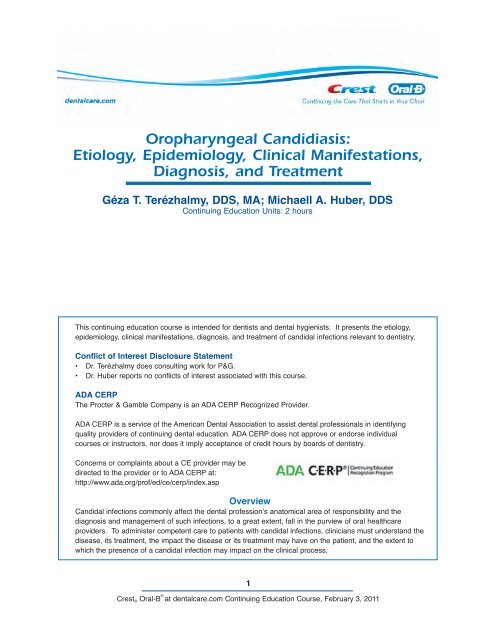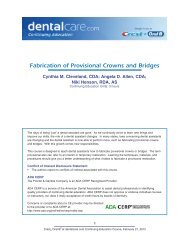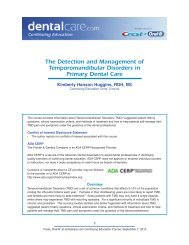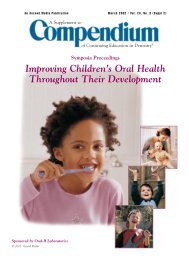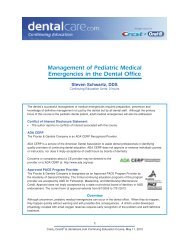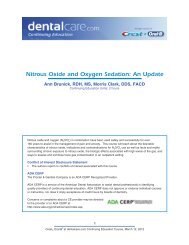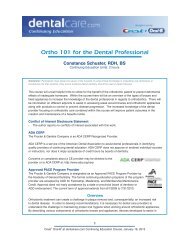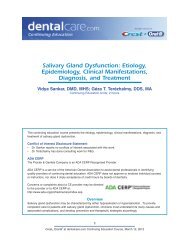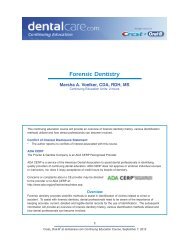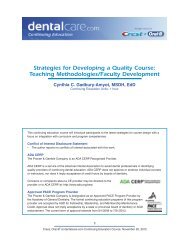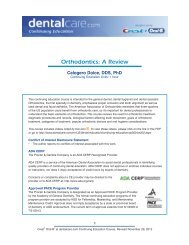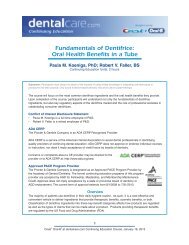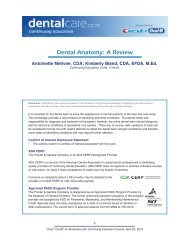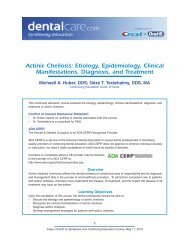Oropharyngeal Candidiasis: Etiology, Epidemiology, Clinical ...
Oropharyngeal Candidiasis: Etiology, Epidemiology, Clinical ...
Oropharyngeal Candidiasis: Etiology, Epidemiology, Clinical ...
You also want an ePaper? Increase the reach of your titles
YUMPU automatically turns print PDFs into web optimized ePapers that Google loves.
<strong>Oropharyngeal</strong> <strong>Candidiasis</strong>:<br />
<strong>Etiology</strong>, <strong>Epidemiology</strong>, <strong>Clinical</strong> Manifestations,<br />
Diagnosis, and Treatment<br />
Géza T. Terézhalmy, DDS, MA; Michaell A. Huber, DDS<br />
Continuing Education Units: 2 hours<br />
This continuing education course is intended for dentists and dental hygienists. It presents the etiology,<br />
epidemiology, clinical manifestations, diagnosis, and treatment of candidal infections relevant to dentistry.<br />
Conflict of Interest Disclosure Statement<br />
• Dr. Terézhalmy does consulting work for P&G.<br />
• Dr. Huber reports no conflicts of interest associated with this course.<br />
ADA CERP<br />
The Procter & Gamble Company is an ADA CERP Recognized Provider.<br />
ADA CERP is a service of the American Dental Association to assist dental professionals in identifying<br />
quality providers of continuing dental education. ADA CERP does not approve or endorse individual<br />
courses or instructors, nor does it imply acceptance of credit hours by boards of dentistry.<br />
Concerns or complaints about a CE provider may be<br />
directed to the provider or to ADA CERP at:<br />
http://www.ada.org/prof/ed/ce/cerp/index.asp<br />
Overview<br />
Candidal infections commonly affect the dental profession’s anatomical area of responsibility and the<br />
diagnosis and management of such infections, to a great extent, fall in the purview of oral healthcare<br />
providers. To administer competent care to patients with candidal infections, clinicians must understand the<br />
disease, its treatment, the impact the disease or its treatment may have on the patient, and the extent to<br />
which the presence of a candidal infection may impact on the clinical process.<br />
1<br />
Crest ® Oral-B ®<br />
at dentalcare.com Continuing Education Course, February 3, 2011
Learning Objectives<br />
Upon the completion of this course, the dental professional should be able to:<br />
• Discuss the etiology and epidemiology of oropharyngeal candidiasis.<br />
• Recognize the clinical manifestations of oropharyngeal candidiasis.<br />
• Pseudomembranous candidiasis.<br />
• Erythematous candidiasis.<br />
• Hyperplastic candidiasis.<br />
• Candida-associated denture stomatitis.<br />
• Other candidal infections (medial rhomboid glossitis, angular cheilitis, keratinized primary lesions with<br />
candidal infections, candidal esophagitis, and chronic mucocutaneous candidiasis).<br />
• Diagnose oropharyngeal candidiasis.<br />
• Develop strategies for the treatment and prevention of oropharyngeal candidiasis.<br />
Course Contents<br />
• Introduction<br />
• <strong>Etiology</strong> and <strong>Epidemiology</strong><br />
• <strong>Clinical</strong> Manifestations of <strong>Oropharyngeal</strong><br />
<strong>Candidiasis</strong><br />
• Pseudomembranous <strong>Candidiasis</strong><br />
• Erythematous <strong>Candidiasis</strong><br />
• Hyperplastic <strong>Candidiasis</strong><br />
• Candida-associated Denture Stomatitis<br />
• Other Candidal Infections<br />
• Diagnosis<br />
• Preventive and Therapeutic Strategies<br />
• Prevention<br />
• Antifungal Chemotherapy: Mild<br />
<strong>Oropharyngeal</strong> <strong>Candidiasis</strong><br />
Nystatin Oral Suspension<br />
Clotrimazole Troches<br />
• Antifungal Chemotherapy: Moderate to<br />
Severe <strong>Oropharyngeal</strong> Infections<br />
Fluconazole<br />
• Antifungal Chemotherapy: Fluconazolerefractory<br />
Disease<br />
Itraconazole, Posaconazole, and<br />
Voriconazole<br />
Caspofungin, Micafungin, and<br />
Anidulafungin<br />
Amphotericin B<br />
• Conclusion<br />
• Course Test<br />
• References<br />
• About the Authors<br />
Introduction<br />
Fungi are free-living, eukaryotic organisms that<br />
exist as yeasts (round fungi), molds (filamentous<br />
fungi), or a combination of these two (dimorphic<br />
fungi). While there are over 100,000 fungal<br />
2<br />
species, only a few are intrinsically pathogenic<br />
in humans. Most pathogenic fungi associated<br />
with human disease are saprophytic members<br />
of the soil microbial flora, i.e., they live on<br />
decaying organic matter. For these organisms,<br />
the lungs are the most common portals of entry.<br />
Some fungi are commensal members of the<br />
normal human flora, i.e., they obtain benefit<br />
without causing harm to their host. In humans,<br />
these are typically found on oral, vaginal, and<br />
gastrointestinal mucosa; or as residents of the<br />
skin and at times of the respiratory epithelium.<br />
In persons with altered homeostatic mechanisms,<br />
commensal organisms may become pathogenic.<br />
Mycoses of interest to oral healthcare providers<br />
are presented in Table 1.<br />
The diagnosis and treatment of most mycoses<br />
is the responsibility of physicians. Infections<br />
caused by the candida spp. represent the most<br />
common mycoses of the oropharyngeal area and<br />
the diagnosis and treatment of some of these<br />
infections fall, to a great extent, in the purview<br />
of the dental profession. To provide timely and<br />
competent care to patients with oropharyngeal<br />
candidiasis, clinicians must understand the<br />
disease, its treatment, the impact the disease<br />
or its treatment may have on the patient, and<br />
the extent to which the presence of a candidal<br />
infection may impact on the clinical process.<br />
<strong>Etiology</strong> and <strong>Epidemiology</strong><br />
As noted earlier, the Candida spp. are<br />
commensal opportunistic organisms typically<br />
found on oropharyngeal tissues. 1-6<br />
Crest ® Oral-B ®<br />
at dentalcare.com Continuing Education Course, February 3, 2011<br />
The reported<br />
carriage rate in healthy individuals varies from<br />
15 to 75 percent, depending on the population
sampled and the sensitivity of the sampling<br />
technique.3 Candida spp. are seldom capable of<br />
initiating serious infections in immunocompetent<br />
patients. Since the pathogenesis of fungal<br />
infections is based on an interplay between host<br />
homeostatic mechanisms and the pathogenicity<br />
of the Candida spp., patients with acquired and<br />
therapeutic immunosuppression (HIV infection,<br />
cytotoxic drugs, corticosteroids), endocrinopathies<br />
(diabetes mellitus, thymoma, polyendocrinopathy<br />
syndrome type 1, hypoparathyroidism,<br />
hypoadrenalism, pregnancy with secondary<br />
infection of the infant), nutritional deficiencies, a<br />
high carbohydrate diet, extended use of broadspectrum<br />
antibacterial agents, qualitative and<br />
quantitative changes in salivary flow (druginduced,<br />
radiotherapy, Sjogren’s syndrome), poor<br />
oral hygiene, the presence of dental prostheses,<br />
age, and smoking are at increased risk of carriage<br />
and infection. 7-17<br />
In one recent study, 81.1% of 122 consecutive<br />
HIV-infected patients on antiretroviral therapy<br />
were colonized by Candida spp. and 33.3% had<br />
clinical infection. 17 In another study, among 210<br />
HIV-positive patients at the time of diagnosis, 62%<br />
had clinical oropharyngeal candidiasis. 7 Other<br />
investigators found (1) that diabetic subjects have<br />
significantly higher candidal colony forming units<br />
(CFU) than nondiabetic subjects, (2) a significant<br />
positive correlation between salivary glucose<br />
levels and candidal CFU, and (3) clinical evidence<br />
3<br />
of oropharyngeal candidiasis in 4% of uncontrolled<br />
diabetic patients with CFU >8,000/mL. 15<br />
C. albicans is the most common isolate from<br />
both healthy individuals and from those at risk of<br />
opportunistic infections. However, an increase in<br />
the prevalence of other members of the Candida<br />
spp. (Table 1) has been reported and a person<br />
may harbor several members of the Candida<br />
spp. at a time. 2,5,17,18 Virulence of the Candida<br />
spp., i.e., the ability to cause invasive mycosis,<br />
is predicated on such factors as their ability to<br />
adhere to epithelial and endothelial cells, their<br />
ability to change phenotype (undergo yeast-tohyphae<br />
transformation), and to secrete proteases<br />
that facilitate cellular penetration. 19<br />
Crest ® Oral-B ®<br />
at dentalcare.com Continuing Education Course, February 3, 2011<br />
C. albicans<br />
appears to be the most virulent member of the<br />
Candida spp. This virulence is attributed largely<br />
to C. albicans’ ability to express a number of<br />
structures that mediate epithelial adherence that<br />
provides protection from the continuous flushing<br />
action of saliva. 3,4 In addition, it is postulated that<br />
the hyphal form of C. albicans is important not<br />
only for epithelial tissue penetration; but also for<br />
escape, following internalization, from phagocytic<br />
cells. 3,20,21<br />
<strong>Clinical</strong> Manifestations of <strong>Oropharyngeal</strong><br />
<strong>Candidiasis</strong><br />
<strong>Oropharyngeal</strong> candidiasis may appear in a<br />
variety of clinical forms. It is often asymptomatic,<br />
but patients may relate a burning sensation
and an altered sense of taste. A classification<br />
system based on clinical criteria provides a<br />
clear distinction between primary oropharyngeal<br />
candidiasis and the oral manifestations of<br />
systemic mucocutaneous candidiasis. 22<br />
Pseudomembranous <strong>Candidiasis</strong><br />
Pseudomembranous candidiasis (PC) is<br />
characterized by the presence of a thick whitish/<br />
yellow velvety pseudomembrane or individual<br />
plaques on oropharyngeal tissues, which may<br />
be wiped away, leaving an erythematous, painful<br />
base that readily bleeds (Figures 1-4). 1,23,24 The<br />
buccal mucosa is the most frequent site, but<br />
all oropharyngeal tissues may be affected.<br />
PC is frequently observed in neonates,<br />
and in patients with acquired or therapeutic<br />
immunosuppression (HIV infection, cytotoxic<br />
Figure 1. Pseudomembranous candidiasis as a<br />
consequence of the extended use of a broad-spectrum<br />
antibacterial agent.<br />
Figure 3. Pseudomembranous candidiasis as a<br />
consequence of chronic use of inhaled corticosteroids<br />
in the management of asthma.<br />
4<br />
drugs, corticosteroids). 7,14,17 In immunocompetent<br />
persons, PC is most likely a consequence of the<br />
extended use of broad-spectrum antibacterial<br />
agents. 24<br />
Erythematous <strong>Candidiasis</strong><br />
Erythematous candidiasis (EC), acute and<br />
chronic, appears as a red patch or patches<br />
usually on the palate or dorsum of the tongue<br />
with concurrent loss of the papillae (Figures 5 &<br />
6). 23,24 EC may affect other oral sites such as the<br />
buccal mucosa and is often asymptomatic. It is<br />
frequently observed with acquired or therapeutic<br />
immunosuppression (HIV infection, cytotoxic<br />
drugs, corticosteroids). 7,17,22 In immunocompetent<br />
patients, EC is most likely a consequence of the<br />
extended use of broad-spectrum antibacterial<br />
agents. 22<br />
Figure 2. Pseudomembranous candidiasis as a<br />
consequence of the extended use of a broad-spectrum<br />
antibacterial agent.<br />
Figure 4. Pseudomembranous candidiasis as a<br />
consequence of chronic use of inhaled corticosteroids<br />
in the management of asthma.<br />
Crest ® Oral-B ®<br />
at dentalcare.com Continuing Education Course, February 3, 2011
Figure 5. Erythematous candidiasis before and after<br />
treatment with nystatin oral suspension.<br />
Figure 7. Hyperplastic candidiasis (candidal<br />
leukoplakia) of the buccal mucosa and tongue as a<br />
consequence of heavy smoking.<br />
Hyperplastic <strong>Candidiasis</strong><br />
Hyperplastic candidiasis is an uncommon<br />
clinical infection characterized by persistent<br />
(chronic), white papules or plaques (Figure<br />
7), which typically affect the buccal mucosa at<br />
the commissural area of a smoker and, less<br />
frequently, the tongue (Figure 8). 1,22-24<br />
This form<br />
infiltrates the epithelium, but when stripped away<br />
does not cause severe pain or bleeding. Also<br />
known as candidal leukoplakia, it is associated<br />
with a malignant transformation rate of up to<br />
15%. 1,22,23,25<br />
Candida-associated Denture Stomatitis<br />
Candida-associated denture stomatitis appears as<br />
an erythematous area beneath a denture-bearing<br />
surface. These lesions are asymptomatic and are<br />
frequently associated with poor oral hygiene. 1,22,25<br />
The clinical presentation ranges from areas<br />
of focal erythema (Figure 9), to generalized<br />
erythema (Figure 10), to granular or papillary<br />
5<br />
Figure 6. Erythematous candidiasis before and after<br />
treatment with nystatin oral suspension.<br />
Figure 8. Hyperplastic candidiasis (candidal<br />
leukoplakia) of the buccal mucosa and tongue as a<br />
consequence of heavy smoking.<br />
erythema (Figures 11 & 12). Candida-associated<br />
denture stomatitis is commonly observed with<br />
angular cheilitis.<br />
Other Candidal Infections<br />
Median rhomboid glossitis appears as an elliptical<br />
or rhomboid erythematous area of depapillation<br />
confined to the dorsal aspect of the tongue<br />
located anterior to the circumvallate papillae<br />
(Figure 13). 22,25 Angular cheilitis appears as<br />
erythematous fissures at the commissures of<br />
the lips. It represents a mixed infection of C.<br />
albicans and coagulase-positive Staphylococcus<br />
aureus. Predisposing conditions include<br />
immunosuppression, poor oral hygiene, a<br />
decrease in the intermaxillary space, and<br />
nutritional deficiencies (Figure 14). 1,22<br />
Keratinized primary lesions with candidal<br />
infection include leukoplakia, lichen planus,<br />
and lupus erythematosus. 1,26<br />
The presence<br />
Crest ® Oral-B ®<br />
at dentalcare.com Continuing Education Course, February 3, 2011
Figure 9. Candida-associated denture stomatitis.<br />
Figure 11. Granular or papillary candida-associated<br />
denture stomatitis before and after treatment with<br />
fluconazole.<br />
Figure 13. Median rhomboid glossitis.<br />
6<br />
Figure 10. Candida-associated denture stomatitis.<br />
Figure 12. Granular or papillary candida-associated<br />
denture stomatitis before and after treatment with<br />
fluconazole.<br />
Figure 14. Angular cheilitis.<br />
Crest ® Oral-B ®<br />
at dentalcare.com Continuing Education Course, February 3, 2011
Figure 15. Chronic mucocutaneous candidiasis<br />
accompanied by chronic persistent onychomycosis.<br />
Figure 17. A fresh 10% KOH cytological smear.<br />
of oropharyngeal candidiasis and symptoms<br />
of dysphagia or odynophagia are the<br />
hallmark of candidal esophagitis. Chronic<br />
mucocutaneous candidiasis, accompanied<br />
by chronic persistent onychomycosis, is a rare<br />
condition observed in patients with a definable<br />
immune defect (Figures 15 & 16). 1,27<br />
Diagnosis<br />
In most cases, the diagnosis of oropharyngeal<br />
candidiasis is based on clinical signs and<br />
symptoms. 22 When the clinical diagnosis is<br />
unclear or the patient does not respond to<br />
empirical antifungal chemotherapy, additional<br />
tests such as (1) exfoliative cytology, (2) tissue<br />
biopsy, or (3) culture and susceptibility testing<br />
may be useful. 9,28<br />
Confirmation of clinical impression of candidiasis<br />
can be obtained by exfoliative cytology. Using<br />
7<br />
Figure 16. Chronic mucocutaneous candidiasis<br />
accompanied by chronic persistent onychomycosis.<br />
Figure 18. Biopsy indicating candidal infiltration into<br />
epithelial tissue.<br />
a sterile instrument or a tongue blade, the<br />
suspected area is scrapped and the harvested<br />
material is spread on a glass slide. The<br />
application of a few drops of 10% potassium<br />
hydroxide (KOH) to the fresh cytological smear<br />
will allow for immediate microscopic examination<br />
of the preparation (Figure 17). 14<br />
Crest ® Oral-B ®<br />
at dentalcare.com Continuing Education Course, February 3, 2011<br />
To improve<br />
sensitivity, the cytological smear may be allowed<br />
to dry, fixed with ethanol, and stained with<br />
periodic acid-Schiff. 17 It is important to note that<br />
the presence of blastophores (budding yeasts)<br />
without hyphae in the absence of clinical signs or<br />
symptoms probably denotes a commensal status.<br />
Biopsy is rarely indicated, but it may reveal<br />
epithelial tissue penetration (Figure 18). 28<br />
Lastly, since in most instances empirical<br />
antifungal chemotherapy is initiated based on<br />
a presumptive, i.e., a clinical diagnosis, if the<br />
infection does not respond to treatment, a culture
and susceptibility test may provide a definitive<br />
diagnosis and identify the presence of resistant<br />
organisms. 17 More rapid, nonculture-based<br />
methods for early diagnosis, such as polymerase<br />
chain reaction (PCR), western blot, antigen<br />
detection, and identification of fungal metabolites<br />
are still considered investigational.<br />
Preventive and Therapeutic Strategies<br />
Fungal and human cells, because of their<br />
phylogenetic similarity are both eukaryotic and<br />
have homologous metabolic pathways for energy<br />
production, protein synthesis and cell division.<br />
Consequently, only a small number of unique<br />
targets for antifungal agents have been identified.<br />
One such target is ergosterol, an essential<br />
structural and functional component of fungal<br />
plasma membranes. This sterol is structurally<br />
different from cholesterol, the predominant sterol<br />
found in mammalian cell membranes. Another<br />
unique target for antifungal chemotherapy is the<br />
fungal cell wall. The cell wall contains a number<br />
of structural proteins, including glucan, absent<br />
in mammalian cells. A third target is fungal<br />
adhesion. Adhesion to host cells is mediated<br />
by binding of a fungal adhesion to a host cell<br />
receptor. Following successful adhesion,<br />
pathogens are able to invade the colonized<br />
Figure 19. Mechanisms of action of antifungal agents.<br />
8<br />
surface, proliferate in deep tissue, and potentially<br />
reach the systemic circulation. Compounds<br />
that antagonize adhesive interactions between<br />
fungal and mammalian cells are currently under<br />
investigation.<br />
The current mainstay of oropharyngeal candidal<br />
chemotherapy are (1) drugs that inhibit<br />
ergosterol synthesis, i.e., azoles; (2) drugs<br />
that disrupt fungal plasma membrane structure<br />
and function by binding to ergosterol, i.e.,<br />
polyenes; and (3) drugs that inhibit the synthesis<br />
of β (1, 3)-D-glucan, an essential component<br />
of the fungal cell wall, i.e., echinocandins<br />
(Figure 19). 29 Two other antifungal agents<br />
with some clinical utility include flucytosine<br />
and griseofulvin. Flucytosine is converted to<br />
5-flurouracil (5-FU), which inhibits thymidylate<br />
syntase and prevents DNA synthesis. While<br />
the Candida spp. are susceptible to flucytosine,<br />
5-FU is cytotoxic in humans. Dose-dependent<br />
toxicity includes bone marrow suppression and<br />
hepatic dysfunction. Griseofulvin, inhibits the<br />
assembly of microtubules and the activity of<br />
accessory proteins essential for the formation of<br />
the mitotic spindle. Following oral administration,<br />
griseofulvin accumulates in the keratinized layer<br />
of cells, making it useful against dermatophytes.<br />
Crest ® Oral-B ®<br />
at dentalcare.com Continuing Education Course, February 3, 2011
Prevention<br />
Appropriate medical treatment of the many<br />
predisposing systemic factors and local measures<br />
such as meticulous oral hygiene, management<br />
of xerostomia, and the maintenance of optimally<br />
functioning and clean prostheses may prevent or<br />
minimize the incidence of clinical oropharyngeal<br />
candidiasis. These measures should include<br />
proper brushing of all oral tissues and all surfaces<br />
of prostheses, removing prostheses at regular<br />
intervals to allow for normal circulation in the<br />
supporting tissues, and periodic evaluation<br />
of prostheses for proper tissue adaption. For<br />
denture-related candidiasis (see below),<br />
disinfection of the denture, in addition to<br />
antifungal chemotherapy is recommended. 30<br />
Antifungal Chemotherapy: Mild<br />
<strong>Oropharyngeal</strong> <strong>Candidiasis</strong><br />
Nystatin oral suspension and clotrimazole troches<br />
are the recommended drugs for the treatment of<br />
mild (uncomplicated) oropharyngeal candidiasis<br />
(Table 2). 27,30 Initially, most patients respond to<br />
these agents, but relapses occur more frequently<br />
than with fluconazole (see below). 27<br />
Nystatin Oral Suspension<br />
Nystatin is a polyene antifungal agent. 2 9 It binds<br />
to ergosterol in fungal plasma membrane and<br />
9<br />
through pore-forming mechanisms increase<br />
membrane permeability, effects leakage of<br />
essential cellular components, and promotes cell<br />
death. To reduce the risk of relapse, treatment<br />
generally should be continued for at least 48<br />
hours after the elimination of all signs and<br />
symptoms associated with the infection. The<br />
oral suspension may also be used as holding<br />
solution for prostheses when they are removed<br />
from the oral cavity. 31 Common adverse effects<br />
include contact mucositis and Stevens-Johnson<br />
syndrome. Serious adverse effects with nystatin<br />
oral suspension are remote as the formulation is<br />
not absorbed systemically.<br />
Clotrimazole Troches<br />
Clotrimazole is an azole antifungal agent. 29<br />
It<br />
blocks 14α-sterol demethylase, a fungusspecific<br />
cytochrome P450 enzyme that initiates<br />
the conversion of lanosterol to ergosterol.<br />
This leads to structural and functional plasma<br />
membrane damage and cell death. Clotrimazole<br />
troches may be effective in the treatment of mild<br />
oropharyngeal candidiasis refractory to nystatin.<br />
However, since clotrimazole troches contain<br />
sucrose, their long-term use may be a problem<br />
in caries-prone patients. Common adverse<br />
effects with clotrimazole include pruritus and a<br />
burning sensation. Serious adverse effects (see<br />
Crest ® Oral-B ®<br />
at dentalcare.com Continuing Education Course, February 3, 2011
fluconazole below) with clotrimazole troches are<br />
remote as the formulation is minimally absorbed.<br />
Antifungal Chemotherapy: Moderate to<br />
Severe <strong>Oropharyngeal</strong> Infections<br />
Fluconazole<br />
Fluconazole is an azole antifungal agent. 29 It<br />
blocks 14α-sterol demethylase (the enzyme<br />
responsible for the demethylation of lanosterol<br />
to egrosterol); and promotes structural and<br />
functional plasma membrane damage, and cell<br />
death. Oral fluconazole is recommended for the<br />
treatment of moderate-to-severe oropharyngeal<br />
candidiasis (Table 2). 27,30 Its clinical activity is<br />
well established against most candida species<br />
(C. krusei is intrinsically resistant and C.<br />
glabrata is increasingly resistant). Following<br />
oral administration fluconazole is well absorbed<br />
(nearly 100% bioavailability) and diffuses freely<br />
into saliva. Unfortunately, the azoles are not<br />
entirely selective for the 14α-sterol demethylase<br />
enzyme. They variably inhibit hepatic cytochrome<br />
P450 enzymes, and are responsible for many<br />
drug-drug interactions. These interactions<br />
are less likely with fluconazole than with<br />
itraconazole, voriconazole, and posaconazole<br />
(see below). Common adverse effects include<br />
nausea, vomiting, diarrhea, and abdominal pain.<br />
Hepatotoxicity is a rare serious adverse effect of<br />
all systemic azole antifungal agents.<br />
Antifungal Chemotherapy: Fluconazolerefractory<br />
Disease<br />
Itraconazole, Posaconazole, and Voriconazole<br />
The azole antifungal agents itraconazole,<br />
posaconazole, and voriconazole appear to have<br />
a broader spectrum of activity than fluconazole<br />
(see above). Fluconazole-refractory infections<br />
should be treated initially with itraconazole<br />
solution or posaconazole suspension (Table 2). 27,30<br />
Voriconazole is recommended when treatment<br />
with other azole antifungal agents has failed<br />
(Table 2). 27,30<br />
Caspofungin, Micafungin, and Anidulafungin<br />
Caspofungin, micafungin, and anidulafungin are<br />
echinocandins.29 They inhibit the synthesis<br />
of β (1, 3)-D-glucan, an essential component<br />
of the fungal cell wall. The echinocandins are<br />
active against most Candida spp., including<br />
those resistant to the azoles (Table 2). 27,30<br />
The<br />
10<br />
three echinocandins appear to be similar in their<br />
efficacy. Common adverse effects include pruritus,<br />
rash, gastrointestinal disturbances, headache,<br />
and fever. Since human cells lack a cell wall and<br />
enzymes involved in glucan synthesis are absent,<br />
the echinocandins have no serious adverse effect<br />
in humans.<br />
Amphotericin B<br />
Amphotericin B is a polyene antifungal agents. 29<br />
It binds to ergosterol in fungal plasma membrane<br />
and through pore-forming mechanism increases<br />
membrane permeability, effect leakage of<br />
essential cellular components and promotes cell<br />
death. Amphotericin B is an important drug in<br />
the treatment of systemic candidal infections and<br />
it is the preferred drug for the treatment of deep<br />
fungal infections during pregnancy (Table 2). 27,30<br />
Common adverse effects include gastrointestinal<br />
disturbances and weight loss. Serious adverse<br />
effects associated with amphotericin B include<br />
(1) an immediate systemic reaction or “cytokine<br />
storm” (release of TNF-α and IL-1), characterized<br />
by fever, chills, and hypotension; (2) renal toxicity,<br />
characterized by afferent arteriole constriction<br />
leading to renal ischemia; and (3) hematologic<br />
toxicity, characterized by anemia secondary to<br />
decreased production of erythropoietin. The newer<br />
lipid formulations of amphotericin B (amphotec,<br />
abelcet, and ambisone) appear to limit renal<br />
toxicity.<br />
Conclusion<br />
Advances in medical and pharmacological<br />
treatment have resulted in greater life expectancy<br />
for patients with acquired or therapeutic<br />
immunosuppression, certain metabolic<br />
disorders, and other systemic conditions that<br />
predispose patients to oropharyngeal and<br />
systemic candidiasis. Oral healthcare providers<br />
must recognize the clinical manifestations of<br />
oropharyngeal candidiasis, and must be familiar<br />
with antifungal treatment strategies and patient<br />
management guidelines. Prompt treatment with<br />
an appropriate antifungal agent can eliminate<br />
infection and prevent systemic dissemination.<br />
This is of critical importance particularly in<br />
immunocompromised patients. Practitioners must<br />
educate patients to improve treatment compliance<br />
and monitor patients’ response to antifungal<br />
therapy. If clinical response to first-line antifungal<br />
therapy is not optimal, referral to a physician is<br />
indicated.<br />
Crest ® Oral-B ®<br />
at dentalcare.com Continuing Education Course, February 3, 2011
To receive Continuing Education credit for this course, you must complete the online test. Please<br />
go to www.dentalcare.com and find this course in the Continuing Education section.<br />
Course Test Preview<br />
1. Which of the following statements is/are correct with respect to the Candida spp.?<br />
a. The Candida spp. are commensal opportunistic organisms.<br />
b. The carriage rate in healthy individuals varies from 15 to 75 percent, depending on the<br />
population sampled and the sensitivity of the sampling technique.<br />
c. Candida spp. is seldom capable of initiating serious infections in immunocompetent patients.<br />
d. All of the above.<br />
2. Patients at increased risk of candidal carriage and infection include those with ___________.<br />
a. acquired and therapeutic immunosuppression<br />
b. endocrinopathies<br />
c. extended use of broad-spectrum antibacterial agents<br />
d. All of the above.<br />
3. All of the following statements are correct with respect to C. albicans except which one?<br />
a. C. albicans is the least common and least virulent isolate from both healthy individuals and from<br />
those at risk of opportunistic infections.<br />
b. The virulence of C. albicans is attributed to some extent to its ability to adhere to epithelial and<br />
endothelial cells.<br />
c. C. albicans is able to express a number of structures that provide protection from the continuous<br />
flushing action of saliva.<br />
d. C. albicans is able to change phenotype, i.e., undergo yeast-to-hyphae transformation, important<br />
for epithelial tissue penetration.<br />
4. All of the following statements are correct with respect to both pseudomembranous and<br />
erythematous oropharyngeal candidiasis except which one? Pseudomembranous and<br />
erythematous oropharyngeal candidiasis are frequently observed in _______________.<br />
a. patients with acquired immunosuppression<br />
b. neonates<br />
c. immunocompetent patients as a consequence of the extended use of broad-spectrum<br />
antibacterial agents<br />
d. patients with therapeutic immunosuppression<br />
5. All of the following statements with respect to hyperplastic candidiasis are correct except<br />
which one? Hyperplastic candidiasis _______________.<br />
a. is an uncommon infection characterized by persistent white papules or plaques<br />
b. typically affect the buccal mucosa at the commissural area of smokers<br />
c. is associated with epithelial infiltration of the Candida organism, which when stripped away<br />
causes severe pain and bleeding<br />
d. also known as candidal leukoplakia, is associated with a malignant transformation rate of up<br />
to 15%<br />
6. All of the following statements with respect to denture stomatitis are correct except which<br />
one?<br />
a. May present as an erythematous area beneath a denture-bearing surface.<br />
b. Is often associated with poor oral hygiene.<br />
c. Is commonly observed with keratinized primary lesions with candidal infection.<br />
d. May present as a granular or papillary erythema.<br />
11<br />
Crest ® Oral-B ®<br />
at dentalcare.com Continuing Education Course, February 3, 2011
7. Dysphagia and/or odynophagia are the hallmark of _______________.<br />
a. median rhomboid glossitis<br />
b. Candidal esophagitis<br />
c. keratinizing primary lesions with candidal infection<br />
d. chronic mucocutaneous candidiasis<br />
8. In most cases, the diagnosis of oropharyngeal candidiasis is based on:<br />
a. <strong>Clinical</strong> signs and symptoms<br />
b. Exfoliative cytology<br />
c. Biopsy<br />
d. Polymerase chain reaction (PCR)<br />
9. The current mainstay of oropharyngeal candidal chemotherapy include all of the following<br />
except which one?<br />
a. Drugs that inhibit ergosterol synthesis, i.e., azoles.<br />
b. Drugs that disrupt fugal plasma membrane structure and function by binding to ergosterol, i.e.,<br />
polyenes.<br />
c. Drugs that inhibit the synthesis of β (1, 3)-D-glucan, an essential component of the fungal cell<br />
wall, i.e., echinocandins.<br />
d. Drugs that inhibit thymidylate synthase and prevents DNA, synthesis, e.g., flucytosine.<br />
10. Appropriate measures to minimize or prevent the incidence of clinical oropharyngeal<br />
candidiasis include _______________.<br />
a. medical treatment of the many predisposing systemic factors<br />
b. local measures such as meticulous oral hygiene and the maintenance of optimally functioning<br />
and clean prostheses<br />
c. management of xerostomia<br />
d. All of the above.<br />
11. The recommended drugs for the treatment of mild (uncomplicated) oropharyngeal<br />
candidiasis include all of the following drugs except which one?<br />
a. Nystatin oral suspension<br />
b. Nystatin pastilles<br />
c. Clotrimazole troches<br />
d. Oral fluconazole<br />
12. Which of the following antifungal agents contain(s) sucrose and their long-term use may be<br />
a problem with extended use in caries-prone patients?<br />
a. Nystatin oral suspension<br />
b. Nystatin pastilles<br />
c. Clotrimazole troches<br />
d. B and C<br />
13. All of the following statements are correct with respect to oral fluconazole except which<br />
one? Oral fluconazole is...<br />
a. recommended for the treatment of moderate-to-severe oropharyngeal candidiasis.<br />
b. is well absorbed from the GI tract and diffuses freely into saliva.<br />
c. commonly associated with hepatotoxicity.<br />
d. the least likely azole to interact with other drugs.<br />
12<br />
Crest ® Oral-B ®<br />
at dentalcare.com Continuing Education Course, February 3, 2011
14. Which of the following drugs is recommended for the treatment of oropharyngeal<br />
candidiasis when treatment with other azole antifungal agents has failed?<br />
a. Itraconazole<br />
b. Posaconazole<br />
c. Voriconazole<br />
d. Clotrimazole<br />
15. All of the following statement are correct with respect to the echinocandins except which<br />
one? The echinocandins (caspofungin, micafungin, and anidulafungin)...<br />
a. are active against most Candida spp., including those resistant to the azoles.<br />
b. appear to be similar in their efficacy.<br />
c. are the most toxic of all of the antifungal agents.<br />
d. are administered IV.<br />
13<br />
Crest ® Oral-B ®<br />
at dentalcare.com Continuing Education Course, February 3, 2011
References<br />
1. Ellepola AN, Samaranayake LP. Oral candidal infections and antimycotics. Crit Rev Oral Biol Med.<br />
2000;11(2):172-98.<br />
2. Kleinegger CL, Lockhart SR, Vargas K, Soll DR. Frequency, intensity, species, and strains of oral<br />
Candida vary as a function of host age. J Clin Microbiol. 1996 Sep;34(9):2246-54.<br />
3. ten Cate JM, Klis FM, Pereira-Cenci T, Crielaard W, de Groot PW. Molecular and cellular<br />
mechanisms that lead to Candida biofilm formation. J Dent Res. 2009 Feb;88(2):105-15.<br />
4. Zhu W, Filler SG. Interactions of Candida albicans with epithelial cells. Cell Microbiol. 2010<br />
Mar;12(3):273-82.<br />
5. Henriques M, Azeredo J, Oliveira R. Candida species adhesion to oral epithelium: factors involved<br />
and experimental methodology used. Crit Rev Microbiol. 2006 Oct-Dec;32(4):217-26.<br />
6. Weindl G, Wagener J, Schaller M. Epithelial cells and innate antifungal defense. J Dent Res. 2010<br />
Jul;89(7):666-75.<br />
7. Bhayat A, Yengopal V, Rudolph M. Predictive value of group I oral lesions for HIV infection. Oral<br />
Surg Oral Med Oral Pathol Oral Radiol Endod. 2010 May;109(5):720-3.<br />
8. Bunetel L, Bonnaure-Mallet M. Oral pathoses caused by Candida albicans during chemotherapy:<br />
update on development mechanisms. Oral Surg Oral Med Oral Pathol Oral Radiol Endod. 1996<br />
Aug;82(2):161-5.<br />
9. Epstein JB, Polsky B. <strong>Oropharyngeal</strong> candidiasis: a review of its clinical spectrum and current<br />
therapies. Clin Ther. 1998 Jan-Feb;20(1):40-57.<br />
10. Hedderwick S, Kauffman CA. Opportunistic fungal infections: superficial and systemic candidiasis.<br />
Geriatrics. 1997 Oct;52(10):50-4,59.<br />
11. Hoppe JE. Treatment of oropharyngeal candidiasis and candidal diaper dermatitis in neonates and<br />
infants: review and reappraisal. Pediatr Infect Dis J. 1997 Sep;16(9):885-94.<br />
12. Kirkpatrick CH, Windhorst DB. Mucocutaneous candidiasis and thymoma. Am J Med. 1979<br />
Jun;66(6):939-45.<br />
13. Navazesh M, Kumar SK. Xerostomia: prevalence, diagnosis, and management. Compend Contin<br />
Educ Dent. 2009 Jul-Aug;30(6):326-33.<br />
14. Rossie K, Guggenheimer J. Oral candidiasis: clinical manifestations, diagnosis, and treatment. Pract<br />
Periodontics Aesthet Dent. 1997 Aug;9(6):635-41.<br />
15. Sashikumar R, Kannan R. Salivary glucose levels and oral candidal carriage in type II diabetics. Oral<br />
Surg Oral Med Oral Pathol Oral Radiol Endod. 2010 May;109(5):706-11.<br />
16. Shay K, Truhlar MR, Renner RP. <strong>Oropharyngeal</strong> candidosis in the older patient. J Am Geriatr Soc.<br />
1997 Jul;45(7):863-70.<br />
17. Thompson GR 3rd, Patel PK, Kirkpatrick WR, Westbrook SD, et al. <strong>Oropharyngeal</strong> candidiasis<br />
in the era of antiretroviral therapy. Oral Surg Oral Med Oral Pathol Oral Radiol Endod. 2010<br />
Apr;109(4):488-95.<br />
18. Li L, Redding S, Dongari-Bagtzoglou A. Candida glabrata: an emerging oral opportunistic pathogen.<br />
J Dent Res. 2007 Mar;86(3):204-15.<br />
19. Fidel PL Jr. Candida-host interactions in HIV disease: relationships in oropharyngeal candidiasis. Adv<br />
Dent Res. 2006 Apr 1;19(1):80-4.<br />
20. Kumamoto CA, Vinces MD. Contributions of hyphae and hypha-co-regulated genes to Candida<br />
albicans virulence. Cell Microbiol. 2005 Nov;7(11):1546-54.<br />
21. Sudbery P, Gow N, Berman J. The distinct morphogenic states of Candida albicans. Trends<br />
Microbiol. 2004 Jul;12(7):317-24.<br />
22. Samaranayake LP, Keung Leung W, Jin L. Oral mucosal fungal infections. Periodontol 2000. 2009<br />
Feb;49:39-59.<br />
23. Akpan A, Morgan R. Oral candidiasis. Postgrad Med J. 2002 Aug;78(922):455-9.<br />
24. Reichart PA, Samaranayake LP, Philipsen HP. Pathology and clinical correlates in oral candidiasis<br />
and its variants: a review. Oral Dis. 2000 Mar;6(2):85-91.<br />
25. Lynch DP. Oral candidiasis. History, classification, and clinical presentation. Oral Surg Oral Med Oral<br />
Pathol. 1994 Aug;78(2):189-93.<br />
14<br />
Crest ® Oral-B ®<br />
at dentalcare.com Continuing Education Course, February 3, 2011
26. Axéll T, Samaranayake LP, Reichart PA, Olsen I. A proposal for reclassification of oral candidosis.<br />
Oral Surg Oral Med Oral Pathol Oral Radiol Endod. 1997 Aug;84(2):111-2.<br />
27. Pappas PG, Kauffman CA, Andes D, Benjamin DK Jr, Calandra TF, et al. <strong>Clinical</strong> practice guidelines<br />
for the management of candidiasis: 2009 update by the Infectious Diseases Society of America. Clin<br />
Infect Dis. 2009 Mar 1;48(5):503-35.<br />
28. Williams DW, Lewis MA. Isolation and identification of Candida from the oral cavity. Oral Dis. 2000<br />
Jan;6(1):3-11.<br />
29. Armstrong AW, Taylor CR. Pharmacology of fungal infections. In: Golan DE, ed. Principles of<br />
Pharmacology. 2nd ed. Philadelphia, PA: Lippincott Williams & Wilkins; 2008.<br />
30. Abramowicz M, ed. Antifungal Drugs. Treatment Guidelines from The Medical Letter. 2009;7:95-102.<br />
31. Siegel MA, Silverman Sol Jr, Sollecito TP. Clinician’s Guide Treatment of Common Oral Conditions.<br />
7th Edition. American Academy of Oral Medicine. 2009.<br />
About the Authors<br />
Géza T. Terézhalmy, DDS, MA<br />
Professor and Dean Emeritus<br />
School of Dental Medicine<br />
Case Western Reserve University<br />
Dr. Terézhalmy is Professor and Dean Emeritus, School of Dental Medicine, Case<br />
Western Reserve University. In addition, he is a Consultant, Naval Postgraduate<br />
Dental School, National Naval Medical Center; and Civilian National Consultant for<br />
Dental Pharmacotherapeutics, Department of the Air Force.<br />
Dr. Terézhalmy earned a B.S. degree from John Carroll University; a D.D.S. degree from Case Western<br />
Reserve University; an M.A. in Higher Education and Human Development from The George Washington<br />
University; and a Certificate in Oral Medicine from the National Naval Dental Center. Dr. Terézhalmy<br />
is certified by the American Board of Oral Medicine and the American Board of Oral and Maxillofacial<br />
Radiology (Life).<br />
Dr. Terézhalmy has many professional affiliations and over the past 40 years, has held more than 30<br />
positions in professional societies. He has served as editor or contributing editor for several publications,<br />
co-authored or contributed chapters for several books and has had over 200 papers and abstracts<br />
published. Dr. Terézhalmy has accepted invitations to lecture before many local, state, national, and<br />
international professional societies.<br />
E-mail: geza.terezhalmy@case.edu<br />
15<br />
Crest ® Oral-B ®<br />
at dentalcare.com Continuing Education Course, February 3, 2011
Michaell A. Huber, DDS<br />
Associate Professor<br />
Head, Oral Medicine Division<br />
Department of Dental Diagnostic Science<br />
The University of Texas Health Science Center at San Antonio, Dental School<br />
Dr. Michaell A. Huber is an Associate Professor, Head, Division of Oral Medicine,<br />
Department of Dental Diagnostic Science, the University of Texas Health Science<br />
Center at San Antonio, Dental School, San Antonio, Texas.<br />
Dr. Huber received his DDS from the University of Texas Health Science Center at San Antonio Dental<br />
School, San Antonio, Texas in 1980 and a Certificate in Oral Medicine from the National Naval Dental<br />
Center, Bethesda, Maryland in 1988. He is certified by the American Board of Oral Medicine. As an<br />
officer of the Dental Corps, United States Navy, Dr. Huber’s assignments included numerous ships<br />
and shore stations and served as Chairman, Department of Oral Medicine and Maxillofacial Radiology<br />
and Director, Graduate Program in Oral Medicine, National Naval Dental Center, Bethesda, Maryland.<br />
In addition he served as Specialty Leader for Oral Medicine to the Surgeon General of the United<br />
States Navy, Washington, DC; and Force Dental Officer, Naval Air Force Atlantic, Norfolk, Virginia. He<br />
has many professional affiliations and over the past 24 years, he has held a variety of positions in<br />
professional organizations.<br />
Since joining the faculty in 2002, Dr. Huber has been teaching both pre-doctoral and graduate dental<br />
students at the University of Texas Health Science Center Dental School, San Antonio, Texas, and is the<br />
Director of the school’s Oral Medicine Tertiary Care Clinic. He is currently serving as the Public Affairs<br />
Chairman for the American Academy of Oral Medicine. Dr. Huber has accepted invitations to lecture<br />
before many local, state, and national professional organizations. He has been published in numerous<br />
journals including: Oral Surgery, Oral Medicine, Oral Pathology, Oral Radiology and Endodontology;<br />
Dental Clinics of North America, Journal of the American Dental Association, and Quintessence<br />
International.<br />
E-mail: huberm@uthscsa.edu<br />
16<br />
Crest ® Oral-B ®<br />
at dentalcare.com Continuing Education Course, February 3, 2011


